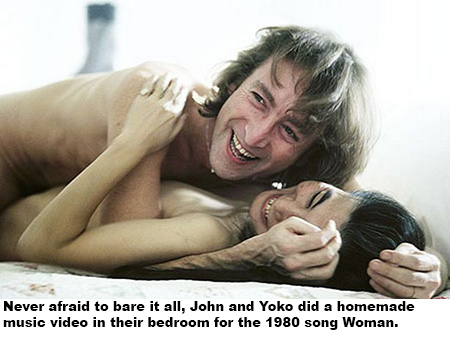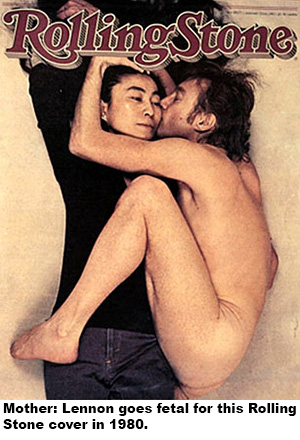John & Yoko: The original oversharing couple
John and Yoko were the original Too Much Information couple, long before Kim Kardashian decided her butt was global news.
Next year marks John Lennon’s 75th birthday, and for some reason I found myself rewatching the documentary Imagine: John Lennon with my wife on DVD. This is a well-made 1988 doc put together from videos, music demos and over 100 hours of Lennon interviews from his early Beatle days to his death in front of the Dakota Hotel in Manhattan in 1980.
What struck me is how public a couple John and Yoko sought to be as the ‘60s — and the Beatles — came to an end and Lennon tried to reconcile his fame with a new decade. There they are, sitting together inside a white sack at a presscon, before a swarm of microphones, journalists asking them what “message” they’re trying to convey by remaining hidden from view.
There they are, lying in a Toronto hotel bed together, surrounded by camera crews — not for anything kinky, just to use the “bed-in” as a pretext for talking about world peace, as they did in 1969.
Before Kim Kardashian decided the Internet was something that needed to be “broken” by releasing yet another picture of her interstellar butt — before James Franco started charting his Instagram views and writing navel-gazing NYT op-ed piece about “selfies” — John and Yoko were there, playing out every moment in public before the cameras and scribes.
There was no Internet, no Facebook or Twitter back in 1970, but it’s tempting to think that, if it were available, John and Yoko, who were practically a public brand by then, would have fully utilized social media to get their
“peace” message across. After all, they rented a Times Square billboard one Christmas to “advertise” that “War Is Over (If You Want It).” (Not coincidentally, that was the refrain from their 1972 pop single hitting the charts at the time.)
John and Yoko were the original Too Much Information couple, the ones who’d tell you about their insecurities. their medical issues, even their bathroom visits (“I had a good sh*t today,” John tells an incredulous visitor to his vast Tittenhurst Estate in England, after the hippie trespasser asks Lennon what his lyrics “mean”). They are born to overshare, eager to take on whatever new trend is in the pipeline — Transcendental Meditation, Primal Scream Therapy, macrobiotic diets — and get up and shout about it in public. Perfect candidates for Facebook, in other words.
And of course, they were more than willing to become naked: the cover of their famous “Two Virgins” LP — recorded during a single all-night recording session of squeals and grunts that ended with the couple “making love at dawn” (Eewww! T.M.I.!) features a completely nude John and Yoko, facing the camera with sullen glares.
Yes, long before Kim Kardashian decided her butt and full-frontal view was the main story, John and Yoko were there, like brave astronauts of oversharing.
The album cover does manage to offend at least one visitor to their bed-in during the Imagine documentary: the cartoonist Al Capp who drew “L’il Abner” and was notoriously dismissive of hippies. “I think everybody owes it to the world to prove that they have pubic hair,” he sneers, waving the album cover around, “and you’ve done it and I applaud you for it.” He then unleashes barbs of racism towards Lennon’s new wife. “You’re not from any race that I belong to,” he continues, until the Lennons decide they’ve heard enough from Capp and send him on his way.
It is true, doing a full-frontal photo session must have seemed pretty “far out” even in 1970, and it’s no wonder the album was packaged in brown wrapping paper. But on the other hand, it is uncannily modern for the Lennons to be obsessed with foisting their bare-naked selves upon the public. Would they be burning up the Twitterverse and Instagram if John and Yoko were still around to work the system today?
Indeed, John and Yoko (and why has this never been shortened to a mash-up name like “Brangelina”? They might have been dubbed “Joko” by the press if they had lived in more frivolous times) don’t just whip off their clothes for album covers. Imagine shows us a homemade video for the song Woman in which the middle-aged couple, arriving home to the white bedroom of their Dakota flat, proceed to play out a softcore porno scenario, stripping down and climbing into bed, which is admittedly a very popular thing to capture on your cell phone nowadays, but not so common in 1980 when the song came out. Again, the emphasis on sharing naked images of themselves seems almost pathological, if not merely strategic.
Arguably, for Joko, there was no line between private and public. Lennon’s first solo album was stripped to the bone — bass, drums, guitar, vocals — in a bid to exorcise the baroque production of the Beatles, but also to show that Lennon had “nothing to hide.” Yoko’s art was always confrontational and conceptual in nature, and often involved permutations of her own body or contortions of her own voice.
Imagine brings us deeper into John Lennon’s psyche, the wounds of losing his mom and a volatile marriage to Cynthia Powell before meeting Yoko (Cynthia, along with first son Julian, gamely shed light on the damaged being that John was before hooking up with Yoko); but it also dwells on the famous “Lost Weekend,” a 14-month break from Yoko in which assistant May Pang was “assigned” to be his companion in Los Angeles. Drunken nights spent heckling the Smothers Brothers in LA clubs ensued, yet another instance in which Lennon could not resist throwing himself before the public eye.
After all this, Lennon retreated from the public eye in 1975 to lick his wounds amid the cocoon of the Dakota, playing househusband and looking after young Sean while working on some new songs, the basis for “Double Fantasy,” his last proper recording before being gunned down. (Yoko, during most of this time, was busy buying and selling Holstein cows for a large profit — a canny businesswoman by any measure.) Lennon seemed to let his guard down most in New York City, a place that generally accepts celebrities as part of the landscape, and usually just lets them be. He didn’t reckon, perhaps, on what a disproportionate, unbalanced relationship fame exerts on its fans.
It would be easy to be snide about the Lennons’ naïveté, as a New York Times reporter is in the documentary: “You can’t possibly believe that what you have done has saved a single life,” the scribe says, chiding their peace efforts. That John and Yoko never actually stopped any wars is perhaps irrelevant. How many wars do people battle nowadays, clicking “Like” buttons on Facebook?
And, as naïve as they were, at least through their efforts he and Yoko were drawing attention to something beyond themselves — something beyond their naked posteriors and selfies — a leap in consciousness this generation is not always so eager to take.















